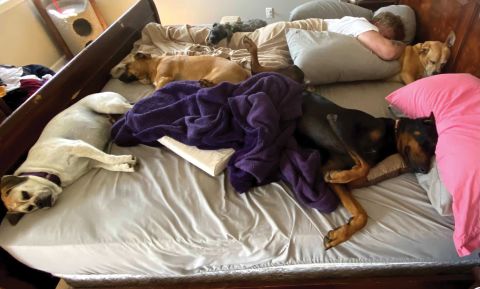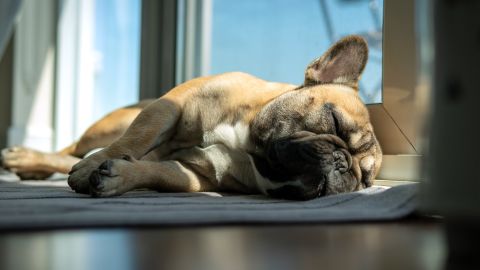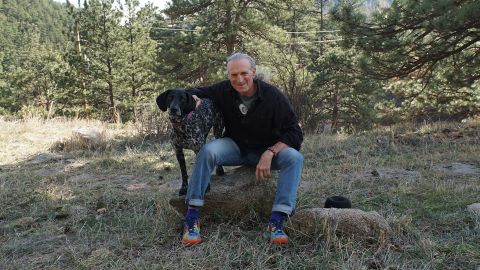
Why do sleeping dogs look like they’re running? Experts weigh in

Photos: Sleeping with pets — from their point of view
Courtesy Brawner Raymond
Is sleeping with your pets good for them? —
“In general, it is a very good thing for animals to sleep with their people,” said Dr. Dana Varble, the chief veterinary officer for the North American Veterinary Community.
“Do you really think there’s enough room for you?” — Delilah, a 10-year-old Siberian husky.

Photos: Sleeping with pets — from their point of view
Courtesy Stephanie Moody/Rue’s Rescue & Sanctuary
“Who says everyone can’t fit in the bed? As long as I get the biggest part so I can spread out, I’m cool.” — Beast (bottom right), a 106-pound European Doberman, with (clockwise from bottom left) his sisters Buttercup and Bear; brother Joey, laying on their human; and sister Bailey.

Photos: Sleeping with pets — from their point of view
David Allan
“Hi I’m Tessie, a 4-year-old Australian cattle dog. I love sleeping with my girls so much that when they go to the store i snuggle with their bed toys until they get back.”

Photos: Sleeping with pets — from their point of view
Sandee LaMotte/CNN
“In the animal world, animals who are bonded tend to sleep together,” Varble said.
Lynx (top) and Luna (bottom) are 2-year-old Siberian Forest cats.

Photos: Sleeping with pets — from their point of view
Courtesy Trent Loyd
“Come on, Dad, that’s enough sports for tonight. It’s time for bed.” — Ellie, a 6-year-old German shorthaired pointer, who likes to sleep under the covers next to her humans.

Photos: Sleeping with pets — from their point of view
Courtesy Stephanie Moody/Rue’s Rescue & Sanctuary
Dogs and cats who share their human’s bed tend to have a “higher trust level and a tighter bond with the humans that are in their lives. It’s a big display of trust on their part,” Varble said.
Banshee, a 6-year-old Husky mix, is a rescue who survived heartworms.

Photos: Sleeping with pets — from their point of view
Courtesy Trent Loyd
“When a dog turns their back to you, it’s an incredible sign of trust because that is a very vulnerable position for them — they can’t keep watch for danger,” Varble said.
Mason, a 3-year-old lab mix, loves to sleep next to his dad every night but hates covers.
Photos: Sleeping with pets — from their point of view
Sandee LaMotte/CNN
“Dogs and cats who are more closely bonded with their humans get additional health benefits,” Varble said, including increases in oxytocin and dopamine, the feel-good hormones.
“What? I don’t snore!” — Luna, a 2-year-old Siberian Forest cat.

Photos: Sleeping with pets — from their point of view
Courtesy Ryan Pollyea
“Make sure all the pets in your house are up to date on flea, tick and internal parasite prevention, especially if you’re going to have them in your bed,” Varble advised.
Molly (left), a 15-year-old cockapoo mix, likes to sleep in her human’s armpit, while Evie (right) prefers the end of the bed and hates to be woken up early.

Photos: Sleeping with pets — from their point of view
Courtesy Ryan Pollyea
“Animals have different personalities like we do,” Varble said. “Some people sleep with the lights on and some people like to sleep in the complete dark. One pet might have more of a protective, another more of an assertive personality.”
Evie, a 4-year-old Jack Russell terrier mix, has been known to crawl onto her human if she needs more affection.
A dog who sleeps at the end of the bed with their face toward the door might have a more protective personality, Varble said.
“Thank goodness that bed hog Beast is gone so I can catch up on my zzz’s.” — Buttercup, a 4-year-old beagle-bulldog mix.

Photos: Sleeping with pets — from their point of view
Sandee LaMotte/CNN
“I may look like an angel, but in the night I have been known to walk or sit on my humans and try to smell their breath. I also enjoy draping my 2-foot-long body across their necks at about 3 a.m.” — Lynx, a 2-year-old Siberian Forest cat.
CNN —
June seems to dream of pursuit. After the long-haired German shepherd settles down for a nap, her floofy, low-slung limbs often begin to twitch and kick. To her owners, she appears to be on the trail of some unseen prey.
“When she’s sleeping sometimes her paws are going aggressively – like, frantically – like she’s running on an invisible treadmill,” said owner Wudan Yan, who lives in Seattle.
“She’s dreaming, right?” Yan said. “She’s dreaming about chasing squirrels and bunnies.”

The kinds of behaviors Yan has observed are common, said neuroscientist Marcos Frank, a professor at Washington State University who studies the function of sleep in animals. “I’ve seen it in my own dogs. They’re running, they’ll whimper, they’ll bark, and they’ll wake themselves up like they don’t know where they are,” he said.
What’s June really dreaming about? Animals’ sleeping lives have sparked human curiosity for thousands of years, but clear answers have been elusive. “If a dog could give us a report, then maybe we could answer the question,” Frank said.
Until then, we’ll have to make do with science. Here’s what we know.
Involuntary muscle jerks called myoclonus are common in both dogs and humans. That’s what you’re seeing when a dog’s limbs and paws quiver or move repeatedly during sleep. It’s most frequent during REM sleep. The flickering eyes, too, are associated with REM.
And in humans, REM sleep has historically been associated with vivid dreaming. It’s the stage where you have the sort of weird, full-color experiences you can’t wait to tell your family about over breakfast.
Dogs get a lot of REM sleep, which accounts for about 12% of their overall lives, according to a 1977 study published by the journal Physiology & Behavior. And since other aspects of sleep in dogs closely resemble our own, scientists said they believe the parallels could extend to dreaming.
“From dogs to humans, most mammals exhibit the same basic states of sleep,” Frank said. “We can’t say conclusively that dogs are having experiences like we do when we dream, but it’s hard not to imagine they are.”
When movement during sleep gets more elaborate, there may be something else happening besides myoclonus.
“Full-blown running in their sleep is not as common,” Frank said. “There’s a mechanism in the brain that actively paralyzes you from the neck down. It’s a fascinating phenomenon, and it’s what normally keeps you from acting out your dreams.”
That structure, called the pons, is located on the brainstem. Damage to the pons can short-circuit its ability to paralyze the sleeping body.
Scientists discovered in the 1970s that adding lesions to the brain stem of house cats led to the animals becoming far more active in their sleep. Cats in the study were seen lifting up their head, moving their limbs and leaping.
Damage done to the pons by neurological disorders can also affect the brain’s ability to paralyze the body during sleep. For humans, a big increase in jerking around while asleep can be an early warning sign of Parkinson’s disease, Frank said. If you see the same thing in your dog, he noted, it’s worth a trip to the vet.
For humans, REM sleep is commonly believed to play a role in consolidating memory. There is some evidence it functions the same way for animals.
In a 2001 study published in the journal Neuron, researchers observing brain-wave activity in sleeping rats concluded the animals were replaying events of the day. When the rats ran a circular maze before drifting off, they appeared to repeat snippets of their maze running as they slept. And in 2017, a study published in the journal Scientific Reports found dogs might use their naptimes to reinforce memories established while awake.

Dogs participating in the study started by learning to follow new voice commands. A week after the initial training, animals that slept – rather than played – after the lesson were able to perform the associated task better than their control-group counterparts. It may be that they, too, were playing back the day’s events in their sleep.
When dogs sleep “there’s no reason not to believe they’re not reliving some kind of previous experience,” said Marc Bekoff, a professor emeritus of ecology and evolutionary biology at the University of Colorado Boulder and the author of “Canine Confidential: Why Dogs Do What They Do.”
That goes for dogs’ wild cousins, too. Bekoff has spent countless hours doing field research that included watching wolves and coyotes sleeping, and he said they exhibit the same behaviors pet owners see in their napping canines.

But even if dogs, wolves and coyotes rehash the events of the day when they are asleep, the results may look (or smell) quite different from human dreams. “We have exceptional vision, but dogs – that’s not their realm,” said Frank, the Washington State professor.
While dogs don’t have the world’s best eyesight, they are phenomenal at smelling.
“I think there’s some sensory context that must conform to what the mental contents are,” he said. “I’ve always wondered, when dogs dream, is it a world of smells they’re experiencing?”

Modern-day pet owners might be particularly riveted by their companions’ sleeping lives, but an interest in animal dreams goes back to ancient times, noted philosopher David M. Peña-Guzmán, associate professor of humanities and liberal studies at San Francisco State University.
“There are references to the dreams of animals in the work of people like Aristotle and a couple of other Greek philosophers,” said Peña-Guzmán, who is also author of the forthcoming book “When Animals Dream: The Hidden World of Animal Consciousness.”
Even then, humans liked to speculate about the dreams of animals that they were close with, such as dogs and horses, he said. Spending ample time with a domesticated animal, Peña-Guzmán noted, makes it easier to imagine them as creatures with rich inner lives. Less cuddly species, such as frogs and insects, tend to get ignored in ancient accounts.

Why is a philosopher interested in animal dreams? In his book, Peña-Guzmán argued that the ability to dream suggests that an animal experiences consciousness. And when we recognize the consciousness of an animal, he wrote, we are more likely to value their experiences, to believe they are deserving of respectful treatment.
And Peña-Guzmán finds dreams throughout the animal kingdom. He described a sleeping octopus whose color turns kaleidoscopic, which some scientists see as evidence of REM sleep. He wrote of zebra finches whose brain activity during sleep looks the same as it does when they’re singing a song. Peña-Guzmán thinks that fish probably dream, too.
Peña-Guzmán acknowledges that not all animal scientists agree with his conclusions about dreams, but one thing is clear: We have a lot to learn about sleeping animals.
“In dreaming you really see the power of the mind at work,” Peña-Guzmán said. “It is a really powerful reminder of how much we have underestimated and understudied animals and the extent to which the animal mind remains this unexplored territory about which we know relatively little.”
Source: https://www.cnn.com/2022/05/10/health/dog-sleep-dreams-wellness/index.html

















